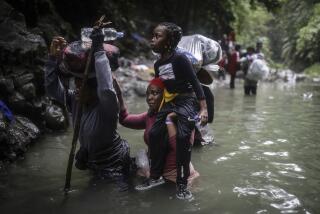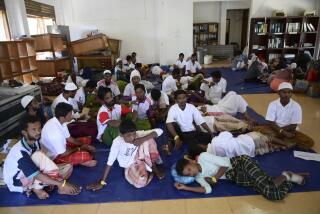Malaysians believe they’ve found 139 graves at suspected trafficking camps
Malaysian authorities have discovered 139 suspected graves in the country’s northern jungles at what they believe were camps used for trafficking humans, police announced Monday.
The discovery underscored the staggering human cost of a smuggling trade that has engulfed the region from Bangladesh to Indonesia.
“It is a very sad scene,” said the country’s police chief, Gen. Khalid Abu Bakar, according to the Associated Press. “I am shocked. We never expected this kind of cruelty.”
Some of the camps appeared to have been abandoned only recently, Khalid told reporters in Wang Kelian, a Malaysian town not far from the site of the discoveries. Police found a haunting assortment of goods scattered among their remains, he said: vegetables, rice, used bullets, a wooden stretcher, a pink teddy bear and white children’s sandals.
Police identified 28 suspected human trafficking camps in the jungle during an investigation that began on May 11, Khalid said. The largest could hold about 300 people. Most of them contained suspected graves -- low mounds, covered with leaves and marked with sticks. At one, they found a mostly decomposed body lying in what appeared to be a makeshift cage.
“I am deeply concerned with graves found on Malaysian soil purportedly connected to people smuggling,” Prime Minister Najib Razak tweeted Monday. “We will find those responsible.”
Police believe smugglers used the camps, found less than a mile from the border with Thailand, to sneak migrants and refugees from Bangladesh and Myanmar to relative prosperity and safety abroad. Many Bangladeshis are fleeing endemic poverty, rights groups say. Rohingya Muslims from Myanmar’s Rakhine state are fleeing decades of persecution.
According to the United Nations, as many as 100,000 Rohingya have fled the country by boat, driven from home by ethnic violence and virtual imprisonment in squalid ghettos.
Human rights groups say that smugglers essentially held the migrants ransom, refusing to allow them further passage unless they paid exorbitant fees. Sometimes they tortured their captives, urging them to pressure their families and friends into providing the money.
Khalid showed reporters photographs taken at the camps, mostly of scattered pens made of sticks, barbed wire and tarpaulin, according to the Associated Press.
“We think the migrants were imprisoned in these wooden pens,” Khalid said. “They were not allowed to move freely and traffickers kept watch at sentry posts.”
Malaysian officials had long denied that such camps existed in their country.
Early this month, Thai police identified a series of mass graves in their country’s southern Songkhla province, not far from the site of Malaysia’s discoveries. Thai authorities, responding to international pressure, cracked down on the smuggling rings, unwittingly precipitating a second crisis: Many smugglers abandoned their wards, leaving thousands of migrants packed onto rickety fishing boats on the Andaman Sea with dwindling supplies of food and water.
Although Indonesia and Malaysia have said that they would shelter the migrants for up to a year before they are relocated to more permanent settlements, the United Nations’ refugee agency estimated on Friday that up to 3,500 of them were still adrift.
Khalid said that police were led to the discovery by gathering intelligence from 37 detained human trafficking suspects. No arrests have yet been made in connection with the discovery.
Follow @JRKaiman on Twitter for news out of Southeast Asia.
More to Read
Start your day right
Sign up for Essential California for news, features and recommendations from the L.A. Times and beyond in your inbox six days a week.
You may occasionally receive promotional content from the Los Angeles Times.






